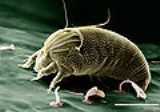
Aceria
Encyclopedia
Aceria is a genus
of mite
belonging to the gall mite family
(Eriophyidae). These tiny animals are parasites of plant
s. Several species can cause gall
s, blister
s and erineum; a few are economically significant pests, while others are useful for biological control of invasive plants such as Rush Skeletonweed (Chondrilla juncea), Creeping Thistle (Cirsium arvense) or Field Bindweed (Convolvulus arvensis).
This genus makes up a significant part (typically 25%–30%) of gall mite biodiversity
across the world.
Genus
In biology, a genus is a low-level taxonomic rank used in the biological classification of living and fossil organisms, which is an example of definition by genus and differentia...
of mite
Mite
Mites, along with ticks, are small arthropods belonging to the subclass Acari and the class Arachnida. The scientific discipline devoted to the study of ticks and mites is called acarology.-Diversity and systematics:...
belonging to the gall mite family
Family (biology)
In biological classification, family is* a taxonomic rank. Other well-known ranks are life, domain, kingdom, phylum, class, order, genus, and species, with family fitting between order and genus. As for the other well-known ranks, there is the option of an immediately lower rank, indicated by the...
(Eriophyidae). These tiny animals are parasites of plant
Plant
Plants are living organisms belonging to the kingdom Plantae. Precise definitions of the kingdom vary, but as the term is used here, plants include familiar organisms such as trees, flowers, herbs, bushes, grasses, vines, ferns, mosses, and green algae. The group is also called green plants or...
s. Several species can cause gall
Gall
Galls or cecidia are outgrowths on the surface of lifeforms caused by invasion by other lifeforms, such as parasites or bacterial infection. Plant galls are abnormal outgrowths of plant tissues and can be caused by various parasites, from fungi and bacteria, to insects and mites...
s, blister
Blister
A blister is a small pocket of fluid within the upper layers of the skin, typically caused by forceful rubbing , burning, freezing, chemical exposure or infection. Most blisters are filled with a clear fluid called serum or plasma...
s and erineum; a few are economically significant pests, while others are useful for biological control of invasive plants such as Rush Skeletonweed (Chondrilla juncea), Creeping Thistle (Cirsium arvense) or Field Bindweed (Convolvulus arvensis).
This genus makes up a significant part (typically 25%–30%) of gall mite biodiversity
Biodiversity
Biodiversity is the degree of variation of life forms within a given ecosystem, biome, or an entire planet. Biodiversity is a measure of the health of ecosystems. Biodiversity is in part a function of climate. In terrestrial habitats, tropical regions are typically rich whereas polar regions...
across the world.
Species
- Aceria anthocoptesAceria anthocoptesAceria anthocoptes also known as the russet mite, rust mite, thistle mite, or the Canada thistle mite is a species of mite that belongs to the family Eriophyidae....
(Nalepa, 1892), rust mite - Aceria banatica Vidovic, 2011
- Aceria bipedis Manson, 1984
- Aceria calystegiae (Lamb 1952)
- Aceria capreae Manson, 1984
- Aceria carmichaeliae Lamb, 1952
- Aceria chondrillaeAceria chondrillaeAceria chondrillae is a biological control agent against Chondrilla juncea , which is a well-known noxious weed....
Canestrini, 1891, skeletonweed gall mite, chondrilla gall mite - Aceria clianthi Lamb, 1952
- Aceria depressae Manson, 1984
- Aceria diospyri Keifer, 1944
- Aceria erinea (Nalepa, 1891)
- Aceria eriobotryae (Keifer, 1938)
- Aceria gallae T.Huang, 1996
- Aceria genistae (Nalepa, 1891)
- Aceria gersoni Manson, 1984
- Aceria gleicheniae Manson, 1984
- Aceria hagleyensis Manson, 1984
- Aceria healyi Manson, 1970
- Aceria jasminoidis Huang, 2001
- Aceria korelli Manson, 1984
- Aceria kuko (Kishida, 1927)
- Aceria labiatiflorae (Thomas, 1872) (= A. oregani)
- Aceria lanyuensis Huang, 2001
- Aceria litchii (Keifer, 1943)
- Aceria litseae (Keifer, 1972)
- Aceria lycopersici (Wolffenstein 1879)
- Aceria malherbaeAceria malherbaeAceria malherbae is a species of gall mite known as the bindweed gall mite. It is used as an agent of biological pest control on invasive species of bindweed, particularly field bindweed ....
, bindweed gall mite - Aceria manukae Lamb, 1952
- Aceria mayae Manson, 1984
- Aceria melicopis Manson, 1984
- Aceria melicyti Lamb, 1953
- Aceria microphyllae Manson, 1984
- Aceria mikaniae (Nalepa, 1918)
- Aceria monoica Huang, 2001
- Aceria parvensis Manson 1972
- Aceria pimeliae Manson, 1984
- Aceria pipturi Keifer, 1966
- Aceria plagianthi Manson, 1984
- Aceria pobuzii Huang, 1996
- Aceria roxburghianae Huang, 2008
- Aceria rubifaciens Lamb, 1953
- Aceria sacchari Wang, 1964
- Aceria serratifoliae Huang, 2008
- Aceria sheldoniAceria sheldoniAceria sheldoni, commonly called the citrus bud mite, is a species of mite belonging to the family Eriophyidae. It feeds in leaf- and flower-buds of Citrus spp, causing deformation to leaves, flowers and fruit, and is a worldwide pest of citrus fruit production.This minute yellowish or pinkish mite...
Ewing 1937, citrus bud mite - Aceria shepherdiae Keifer, 1966
- Aceria simonensis Manson, 1984
- Aceria spicati (Stebbins, 1909)
- Aceria strictae Manson, 1984
- Aceria sylvestrae Huang, 2008
- Aceria taiwanensis Huang, 2008
- Aceria tenuifolii Manson, 1984
- Aceria titirangiensis Lamb 1953
- Aceria tulipae (Keifer, 1938)
- Aceria victoriae Ramsay, 1958
- Aceria waltheri (Keifer, 1939)
- Aceria virosae Huang, 2008
- Aceria yushania K. Huang, 2001
- Aceria zoysima Manson, 1989

